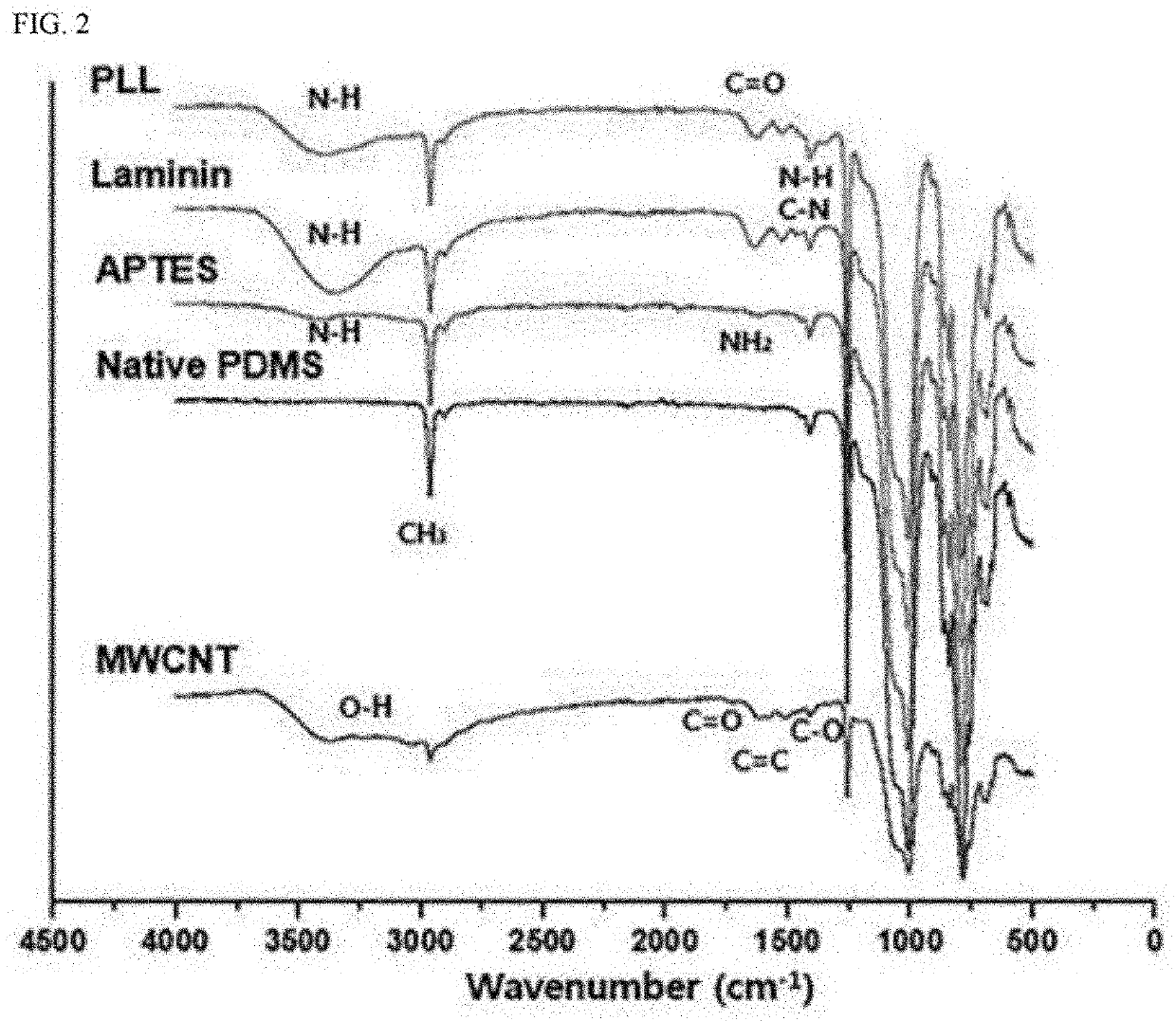Manufacture of structure capable of forming three-dimensional neuronal spheroid and generating neurite through various surface processes
a technology of surface processes and structures, applied in biochemistry apparatuses, instruments, apoptosis detection, etc., can solve the problems of uneven shape of neuronal spheroides and inability to grow neurites, and achieve the effect of mimicking in vivo nerve cells
- Summary
- Abstract
- Description
- Claims
- Application Information
AI Technical Summary
Benefits of technology
Problems solved by technology
Method used
Image
Examples
example 2
[Example 2] Confirmation of Chemical, Surface and Physical Properties of Surface
[0044]To determine a chemical difference in surfaces of concave microwells coated with several substances, it was confirmed that the five concave microwells showed different chemical properties using Fourier transform infrared (FTIR) spectroscopy (FIG. 2). Also, it was confirmed that the different substances were attached to the surfaces of the concave microwells using an atomic force microscope (AFM) (FIG. 3). In addition, it was confirmed that the highest contact angle was formed on a surface of polydimethylsiloxane itself and the smallest contact angle was formed on the surface treated with poly-L-lysine when the contact angle was measured (FIG. 4).
example 3
[Example 3] Experiment for Attachment of Nerve Cells
[0045]To measure an interaction force between the cells and the structure, an experiment for attachment of nerve cells to five surfaces having different properties, which were manufactured by a surface process, was performed. 2*105 nerve cells were seeded under each surface condition, and cultured for 3 hours, and a culture medium was then replaced three times to remove non-adherent cells. To measure an amount of the remaining cells, the cells were quantified using Cell Counting Kit-8 (Dojindo, USA). As a result, it was confirmed that the smallest amount of cells were attached to the surface of polydimethylsiloxane itself, and the highest amount of cells were attached to the surface treated with poly-L-lysine (FIG. 5).
example 4
[Example 4] Formation of Neuronal Spheroids
[0046]A formation period of the neuronal spheroids was determined under different surface conditions. The neuronal spheroids were formed within one day after cell seeding in the concave microwells made of polydimethylsiloxane and the concave microwells surface-treated with carbon nanotubes. It was shown that the neuronal spheroids were formed on day 5 after cell seeding in the case of the concave microwells treated with APTES, and the neuronal spheroids were not formed even after 10 days in the case of the concave microwells treated with laminin or poly-L-lysine. Meanwhile, it was confirmed that there was no significant difference in size between the generated neuronal spheroids (FIG. 6).
PUM
| Property | Measurement | Unit |
|---|---|---|
| diameter | aaaaa | aaaaa |
| diameter | aaaaa | aaaaa |
| size | aaaaa | aaaaa |
Abstract
Description
Claims
Application Information
 Login to View More
Login to View More - R&D
- Intellectual Property
- Life Sciences
- Materials
- Tech Scout
- Unparalleled Data Quality
- Higher Quality Content
- 60% Fewer Hallucinations
Browse by: Latest US Patents, China's latest patents, Technical Efficacy Thesaurus, Application Domain, Technology Topic, Popular Technical Reports.
© 2025 PatSnap. All rights reserved.Legal|Privacy policy|Modern Slavery Act Transparency Statement|Sitemap|About US| Contact US: help@patsnap.com



